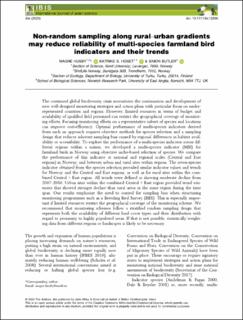| dc.contributor.author | Husby, Magne | |
| dc.contributor.author | Hoset, Katrine S. | |
| dc.contributor.author | Butler, Simon | |
| dc.date.accessioned | 2021-03-08T09:46:40Z | |
| dc.date.available | 2021-03-08T09:46:40Z | |
| dc.date.created | 2020-12-21T14:31:58Z | |
| dc.date.issued | 2020 | |
| dc.identifier.citation | Husby, M., Hoset, K. S. & Butler, S. (2020). Non-random sampling along rural–urban gradients may reduce reliability of multi-species farmland bird indicators and their trends. Ibis, 163(2), 579-592. doi: | en_US |
| dc.identifier.issn | 1474-919X | |
| dc.identifier.uri | https://hdl.handle.net/11250/2732087 | |
| dc.description.abstract | The continued global biodiversity crisis necessitates the continuation and development of new well‐designed monitoring strategies and action plans with particular focus on under‐represented countries and regions. However, limited resources in terms of budget and availability of qualified field personnel can restrict the geographical coverage of monitoring efforts. Focusing monitoring efforts on a representative subset of species and locations can improve cost‐efficiency. Optimal performance of multi‐species indicators derived from such an approach requires objective methods for species selection and a sampling design that reduces inherent sampling bias caused by regional differences in habitat availability or accessibility. To explore the performance of a multi‐species indicator across different regions within a nation, we developed a multi‐species indicator (MSI) for farmland birds in Norway using objective niche‐based selection of species. We compare the performance of this indicator at national and regional scales (Central and East regions) in Norway, and between urban and rural sites within regions. The seven‐species indicator obtained from the species selection provided similar indicator values and trends for Norway and the Central and East regions, as well as for rural sites within the combined Central + East region. All trends were defined as showing moderate decline from 2007–2016. Urban sites within the combined Central + East region provided trend estimates that showed stronger decline than rural areas in the same region during the time span. Our results emphasize the need to control for sampling bias when structuring monitoring programmes such as a Breeding Bird Survey (BBS). This is especially important if limited resources restrict the geographical coverage of the monitoring scheme. We recommend that monitoring schemes follow a stratified random sampling design that represents both the availability of different land cover types and their distribution with regard to proximity to highly populated areas. If that is not possible, statistically weighting data from different regions or landscapes is likely to be necessary. | en_US |
| dc.language.iso | eng | en_US |
| dc.publisher | Wiley | |
| dc.rights | Navngivelse-Ikkekommersiell 4.0 Internasjonal | * |
| dc.rights.uri | http://creativecommons.org/licenses/by-nc/4.0/deed.no | * |
| dc.title | Non-random sampling along rural–urban gradients may reduce reliability of multi-species farmland bird indicators and their trends | en_US |
| dc.type | Peer reviewed | en_US |
| dc.type | Journal article | en_US |
| dc.description.version | publishedVersion | en_US |
| dc.rights.holder | © 2020 The Author(s) | en_US |
| dc.subject.nsi | VDP::Matematikk og Naturvitenskap: 400::Basale biofag: 470 | en_US |
| dc.subject.nsi | VDP::Matematikk og Naturvitenskap: 400::Zoologiske og botaniske fag: 480::Økologi: 488 | en_US |
| dc.source.pagenumber | 579-592 | en_US |
| dc.source.volume | 163 | en_US |
| dc.source.journal | Ibis | en_US |
| dc.source.issue | 2 | en_US |
| dc.identifier.doi | 10.1111/ibi.12896 | |
| dc.identifier.cristin | 1862408 | |
| dc.description.localcode | Paid Open Access | en_US |

